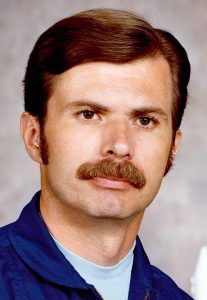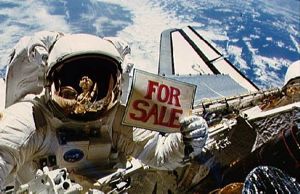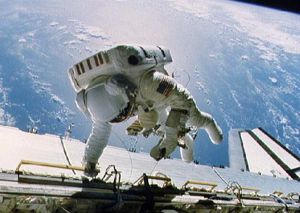
Home - Search - Browse - Alphabetic Index: 0- 1- 2- 3- 4- 5- 6- 7- 8- 9
A- B- C- D- E- F- G- H- I- J- K- L- M- N- O- P- Q- R- S- T- U- V- W- X- Y- Z
Gardner, Dale Allan
 Gardner Credit: www.spacefacts.de |
Status: Deceased; Active 1978-1986. Born: 1948-11-08. Died: 2014-02-19. Spaceflights: 2 . Total time in space: 14.04 days. Birth Place: Fairmont, Minnesota.
Following graduation from the University of Illinois at Urbana, Gardner became a US naval aviator and test pilot, serving at Patuxent River from May 1971 to July 1973 in test and evaluation of the F-14 Tomcat fighter. Following several cruises with the new fighter, he was selected by NASA as a mission specialist astronaut in 1978. Following his two space missions, during which he chalked up two EVS's with 0.51 days total time, he was to have flown aboard the first shuttle launch from Vandenberg AFB. When this was cancelled after the Challenger disaster, he returned to the Navy, serving in several space-related positions until retirement in 1990. Thereafter he worked for TRW in Colorado Springs.
Official NASA Biography as of June 2016:Guy S. Gardner
NASA Astronaut (former)
PERSONAL DATA: Born January 6, 1948, in Alta Vista, Virginia, and grew up in Alexandria, Virginia. Married to the former Linda A. McCabe of Guilderland, New York. They have three wonderful children: Jennifer, Sarah, and Jason.
EDUCATION: Was graduated from George Washington High School in Alexandria, Virginia in 1965; received a bachelor of science degree with majors in astronautics, mathematics, and engineering sciences from the United States Air Force Academy in 1969 and a master of science degree in astronautics from Purdue University in 1970.
SPECIAL HONORS: Air Force Legion of Merit, 2 Defense Superior Service Medals, Defense Distinguished Service Medal, 3 Air Force Distinguished Flying Crosses, 14 Air Medals, National Intelligence Medal of Achievement, Distinguished Graduate of the USAF Academy, Top Graduate in Pilot Training, and Top Graduate from the USAF Test Pilot School, Test Pilot School Outstanding Academic Instructor, Test Pilot School Outstanding Flying Instructor, and Distinguished Astronaut Engineering Alumnus of Purdue University.
EXPERIENCE: Gardner completed U.S. Air Force pilot training at Craig Air Force Base, Alabama, and F-4 upgrade training at MacDill Air Force Base, Florida in 1971. In 1972, he flew 177 combat missions in Southeast Asia while stationed in Uborn, Thailand. In 1973-74, he was an F-4 instructor and operational pilot at Seymour Johnson Air Force Base, North Carolina. He attended the USAF Test Pilot School at Edwards Air Force Base California, in 1975, and then served as a test pilot with the 6512th Test Squadron located at Edwards in 1976. In 1977-78, he was an instructor test pilot at the USAF Test Pilot School. In 1979-1980, he was operations officer of the 1st Test Squadron at Clark Air Base, Philippines.
NASA EXPERIENCE: Gardner was selected as a pilot astronaut by NASA in May 1980. During his 11 years as an astronaut, he worked in many areas of Space Shuttle and Space Station development and support. In 1984, he was assigned as pilot on the first Space Shuttle mission to launch from Vandenberg AFB, California. That mission was later canceled. Gardner first flew in space as pilot on the crew of STS-27, aboard the Orbiter Atlantis, on December 2-6, 1988. The mission carried a Department of Defense payload. Gardner next flew as pilot on the crew of STS-35, aboard the Orbiter Columbia, on December 2-10, 1990. The mission carried the ASTRO-1 astronomy laboratory consisting of three ultraviolet telescopes and one x-ray telescope.
Gardner left NASA in June 1991 to command the USAF Test Pilot School at Edwards Air Force Base, California.
In August 1992, Gardner retired from the Air Force and returned to NASA to direct the joint U.S. and Russian Shuttle-Mir Program.
DECEMBER 1994
Official NASA Biography
NAME: Dale A. Gardner
NASA Astronaut (former)
PERSONAL DATA: Born November 8, 1948 in Fairmont, Minnesota. Grew up in Sherburn, Minnesota and Savanna, Illinois. Considers his hometown to be Clinton, Iowa, where his mother, Mrs. Alice Gardner, resides. Now lives in Colorado Springs, Colorado. Divorced. Two children. An avid sports enthusiast, he enjoys snow skiing, golfing, tennis, and jogging. Other interests include woodworking and photography.
EDUCATION: Graduated as Valedictorian of his class from Savanna Community High School, Savanna, Illinois, in 1966. Received bachelor of science degree in Engineering Physics from the University of Illinois (Urbana-Champaign) in 1970.
ORGANIZATIONS: Member, Phi Eta Sigma, Sigma Tau, and Tau Beta Pi. Fellow, American Astronautical Society.
SPECIAL HONORS: Defense Superior Service Medal (1984, 1989, 1990); Distinguished Flying Cross (1989); Meritorious Unit Commendation (1976); Humanitarian Service Medal (1979); Sea Service Deployment Ribbon (1984). Other honors include the NASA Space Flight Medal (1983 and 1984); Master Space Badge (1989); Lloyd's of London Meritorious Service Medal (1984).
EXPERIENCE: Upon graduation from the University of Illinois in 1970, Gardner entered into active duty with the U.S. Navy and was assigned to the Aviation Officer Candidate School at Pensacola, Florida. He was commissioned an Ensign and was selected as the most promising naval officer from his class. In October 1970 he began Basic Naval Flight Officer training with the VT-10 squadron at Pensacola, graduating with the highest academic average ever achieved in the history of the squadron. He proceeded to the Naval Technical Training Center at Glynco, Georgia, for Advanced Flight Officer training and was selected a Distinguished Naval Graduate and awarded his Naval Flight Officer wings on May 5, 1971. At the Naval Air Test Center Patuxent River, Maryland, from May 1971 to July 1973, he was assigned to the Weapons Systems Test Division and involved in initial F-14 TOMCAT developmental test and evaluation as Project Officer for Inertial Navigation and Avionics Systems. Gardner's next assignment was with the first operational F-14 squadron (VF-1) at NAS Miramar, San Diego, California, from where he flew the TOMCAT and participated in two Western Pacific and Indian Ocean cruises while deployed aboard the aircraft carrier USS ENTERPRISE. From December 1976 until July 1978, he was assigned to Air Test and Evaluation Squadron 4(VX-4) at NAS Pt. Mugu, California, involved in the operational test and evaluation of Navy fighter aircraft.
NASA EXPERIENCE: Gardner was selected as an Astronaut
Candidate by NASA in January 1978, reporting to the Johnson Space Center in July
1978. In August 1979 he completed a 1-year training and evaluation period,
making him eligible for assignment as a Mission Specialist Astronaut. He
subsequently served as the Astronaut Project Manager for the flight software in
the Shuttle onboard computers leading up to the first flight in April 1981. He
then served as a Support Crew Astronaut for the fourth flight (STS-4). He flew
as a mission specialist on STS-8 (August 30 to September 5, 1983) and STS-51A
(November 8-16, 1984). Gardner logged a total of 337 hours in space and 225
orbits of the Earth on these two flights. He has logged more than 2300 hours
flying time in over 20 different types of aircraft and spacecraft. Prior to the
Challenger accident, Gardner was chosen to be a member of the first Shuttle
mission to launch from Vandenberg Air Force Base, California, into a polar
orbit. That flight and the Vandenberg launch capability itself were canceled
after the accident.
In October 1986, following 8-1/2 years with NASA, Gardner returned to his Navy
duties and was assigned to the U.S. Space Command, Colorado Springs, Colorado.
He served over two years as the Deputy Chief, Space Control Operations Division
in Cheyenne Mountain Air Force Base and, after promotion to the rank of Captain
in June 1989, became the command's Deputy Director for Space Control at Peterson
Air Force Base. His space control responsibilities included the surveillance and
tracking of all man-made objects in Earth orbit and the protection of U.S. and
friendly space systems. Gardner retired from the U.S. Navy in October 1990 and
accepted a position with TRW Inc. in Colorado Springs, Colorado. He is a program
manager in the Colorado Springs Engineering Operations of TRW's Space and
Defense Sector. In that capacity, he is involved in the development of both
civilian space and military space and defense high technology programs.
SPACE FLIGHT EXPERIENCE: STS-8 launched from the
Kennedy Space Center, Florida on August 30, 1983. The crew aboard Space Shuttle
Challenger included Richard Truly (Spacecraft Commander), Daniel Brandenstein
(Pilot), and fellow Mission Specialists Guion Bluford and William Thornton. This
was the third flight of the Orbiter Challenger and the first night launch and
landing mission of the Shuttle program. During the flight, the crew of STS-8
deployed the Indian National Satellite (INSAT-1B), operated and tested the
Canadian-build Remote Manipulator System (RMS) robot arm, and performed numerous
earth resources and space science experiments. STS-8 completed 98 Earth orbits
in 145 hours before landing at Edwards Air Force Base, California on September
5, 1983.
STS-51A, the fourteenth flight of the Shuttle program, launched on November 8,
1984 (his birthday). The crew aboard Space Shuttle Discovery included Frederick
Hauck (Spacecraft Commander), David Walker (Pilot), and fellow Mission
Specialists Joseph Allen and Anna Fisher. This was the second flight of
Discovery. During this mission the crew deployed two satellites, Canada's ANIK
D-2 (TELESAT-H) and the Hughes' LEASAT-1 (SYNCOM IV-1), now in service with the
U.S. Navy. In a dramatic salvage effort, they also rendezvoused with and
returned from space two satellites previously launched into improper orbits, the
Indonesian PALAPA B-2 and the Western Union WESTAR VI communication satellites.
Gardner and Allen completed two space walks totaling 12 hours and flew the
Manned Maneuvering Unit (MMU) backpack during the salvage operation. STS-51A
completed 127 orbits of the Earth before landing at the Kennedy Space Center on
November 16, 1984.
DECEMBER 1994
More at: Gardner.
Family: Astronaut. Country: USA. Flights: STS-8, STS-41-H, STS-51-A, STS-62-A. Projects: STS. Agency: USAF. Bibliography: 12, 5417.
 | STS-51-A Astronaut Dale Gardner holds up for sale sign after EVA Credit: NASA |
 | STS-51-A Astronaut Dale Gardner tethered to Discovery's starboard side. Credit: NASA |
1948 November 8 - .
- Birth of Dale Allan Gardner - . Nation: USA. Related Persons: Gardner. American engineer mission specialist astronaut 1978-1986. 2 spaceflights, 14.0 days in space. Flew to orbit on STS-8 (1983), STS-51A..
1978 January 16 - .
- NASA Astronaut Training Group 8 selected. - .
Nation: USA.
Related Persons: Bluford,
Brandenstein,
Buchli,
Coats,
Covey,
Creighton,
Fabian,
Fisher,
Gardner,
Gibson,
Gregory,
Griggs,
Hart,
Hauck,
Hawley,
Hoffman,
Lucid,
McBride,
McNair,
Mullane,
Nagel,
Nelson,
Onizuka,
Resnik,
Ride,
Scobee,
Seddon,
Shaw,
Shriver,
Stewart,
Sullivan.
The group was selected to provide pilot, engineer, and scientist astronauts for space shuttle flights. Recruit women and minorities to introduce diversity into the astronaut corps. Qualifications: Pilots: Bachelor's degree in engineering, biological science, physical science or mathematics. Advanced degree desirable. At least 1,000 flight-hours of pilot-in-command time. Flight test experience desirable. Excellent health. Vision minimum 20/50 uncorrected, correctable to 20/20 vision; maximum sitting blood pressure 140/90. Height between 163 and 193 cm.
Mission Specialists: Bachelor's degree in engineering, biological science, physical science or mathematics and minimum three years of related experience or an advanced degree. Vision minimum 20/150 uncorrected, correctable to 20/20. Maximum sitting blood pressure of 140/90. Height between 150 and 193 cm.. 8,079 applicants, of which half met the basic qualifications. 208 invited for physical tests and interviews. Of the 35 selected, six were women, three were male African-Americans, and one was a male Asian-American.
1983 August 30 - . 06:32 GMT - . Launch Site: Cape Canaveral. Launch Complex: Cape Canaveral LC39A. Launch Platform: MLP2. LV Family: Shuttle. Launch Vehicle: Space Shuttle.
- STS-8 - .
Call Sign: Challenger. Crew: Bluford,
Brandenstein,
Gardner,
Thornton, Bill,
Truly.
Payload: Challenger F03 / PFTA. Mass: 13,642 kg (30,075 lb). Nation: USA.
Related Persons: Bluford,
Brandenstein,
Gardner,
Thornton, Bill,
Truly.
Agency: NASA Houston.
Program: STS.
Class: Manned.
Type: Manned spaceplane. Flight: STS-8.
Spacecraft Bus: Shuttle.
Spacecraft: Challenger.
Duration: 6.05 days. Decay Date: 1983-09-05 . USAF Sat Cat: 14312 . COSPAR: 1983-089A. Apogee: 313 km (194 mi). Perigee: 306 km (190 mi). Inclination: 28.50 deg. Period: 90.70 min.
First night launch and night landing. Deployed Insat 1B. Payloads: Deployment of INSAT (lndia communica-tion satellite) with Payload Assist Module (PAM)-D, Payload Flight Test Article (PFTA)/ Payload Deployment Retrieval System (PDRS), Continuous Flow Electrophoresis (CFES), biomedical experiments. 250,000 express mail envelopes with special cachet for U.S. Postal Service were carried for a first-day cover.
1983 September 5 - .
- Landing of STS-8 - . Return Crew: Bluford, Brandenstein, Gardner, Thornton, Bill, Truly. Nation: USA. Related Persons: Bluford, Brandenstein, Gardner, Thornton, Bill, Truly. Program: STS. Flight: STS-8. STS-8 landed at 07:40 GMT. .
1984 September - .
- STS-41-H (cancelled) - . Crew: Allen, Casserino, Fisher, Gardner, Hauck, Payton, Walker, Dave. Backup Crew: Joseph. Payload: DoD or TDRS Mission. Nation: USA. Program: STS. Flight: STS-41-H. Planned Department of Defense or TDRS deployment shuttle mission. Cancelled due to IUS failure..
1984 November 8 - . 12:15 GMT - . Launch Site: Cape Canaveral. Launch Complex: Cape Canaveral LC39A. Launch Platform: MLP2. LV Family: Shuttle. Launch Vehicle: Space Shuttle.
- STS-51-A - .
Call Sign: Discovery. Crew: Allen,
Fisher,
Gardner,
Hauck,
Walker, Dave.
Payload: Discovery F02 / PLT. Mass: 20,550 kg (45,300 lb). Nation: USA.
Related Persons: Allen,
Fisher,
Gardner,
Hauck,
Walker, Dave.
Agency: NASA Houston.
Program: STS.
Class: Manned.
Type: Manned spaceplane. Flight: STS-51-A.
Spacecraft Bus: Shuttle.
Spacecraft: Discovery.
Duration: 7.99 days. Decay Date: 1984-11-16 . USAF Sat Cat: 15382 . COSPAR: 1984-113A. Apogee: 297 km (184 mi). Perigee: 289 km (179 mi). Inclination: 28.40 deg. Period: 90.40 min.
Manned five crew. First retrieval of two satellites (PALAPA B-2 and WESTAR Vl) for return to earth. Deployed Anik D2, Leasat 2; recovered Westar 6, Palapa B2. Payloads: Telesat (Canada communications satellite)-H with Payload Assist Module (PAM)-D deploy-ment, Syncom IV-1 communications satellite deployment with its unique stage, retrieval of PALAPA B-2 and WESTAR VI communications satellites with PAM-D which failed to ignite on the STS-41-B mission. Manned maneuvering unit (MMU) used for retrieval. Diffusive Mixing of Organic Solutions (DMOS) experiment.
1984 November 12 - . 13:25 GMT - .
- EVA STS-51-A-1 - . Crew: Allen, Gardner. EVA Duration: 0.26 days. Nation: USA. Related Persons: Allen, Gardner. Program: STS. Class: Manned. Type: Manned spaceplane. Flight: STS-51-A. Spacecraft Bus: Shuttle. Spacecraft: Discovery. Retrieved Palapa satellite..
1984 November 14 - .
- EVA STS-51-A-2 - . Crew: Allen, Gardner. EVA Duration: 0.25 days. Nation: USA. Related Persons: Allen, Gardner. Program: STS. Class: Manned. Type: Manned spaceplane. Flight: STS-51-A. Spacecraft Bus: Shuttle. Spacecraft: Discovery. Retrieved Westar satellite..
1984 November 16 - .
- Landing of STS-51-A - . Return Crew: Allen, Fisher, Gardner, Hauck, Walker, Dave. Nation: USA. Related Persons: Allen, Fisher, Gardner, Hauck, Walker, Dave. Program: STS. Flight: STS-51-A. STS-51-A landed at 12:14 GMT. .
1986 July - .
- STS-62-A (cancelled) - . Crew: Aldridge, Crippen, Gardner, Gardner, Guy, Mullane, Ross, Watterson. Backup Crew: Odle. Payload: DoD Mission. Nation: USA. Program: STS. Flight: STS-62-A. Spacecraft Bus: Shuttle. Spacecraft: Discovery. Planned Department of Defense shuttle mission. Cancelled after Challenger disaster. Would have been first launch from the ill-fated SLC-6 launch site at Vandenberg, California..
2014 February 19 - .
- Death of Dale Allan Gardner. - . Related Persons: Gardner. American engineer mission specialist astronaut 1978-1986. 2 spaceflights, 14.0 days in space. Flew to orbit on STS-8 (1983), STS-51A..
Back to top of page
Home - Search - Browse - Alphabetic Index: 0- 1- 2- 3- 4- 5- 6- 7- 8- 9
A- B- C- D- E- F- G- H- I- J- K- L- M- N- O- P- Q- R- S- T- U- V- W- X- Y- Z
© 1997-2019 Mark Wade - Contact
© / Conditions for Use